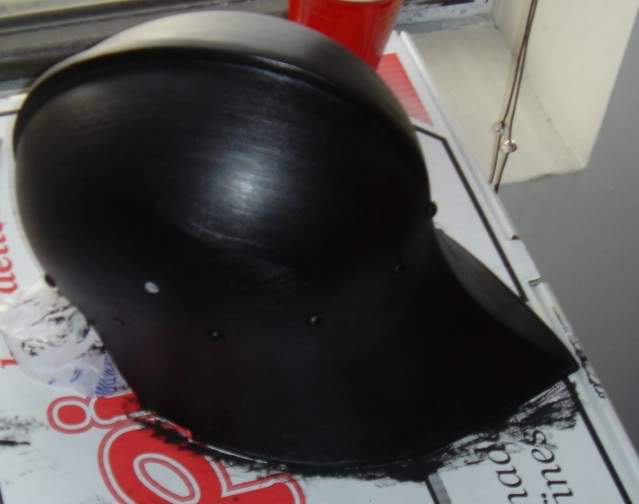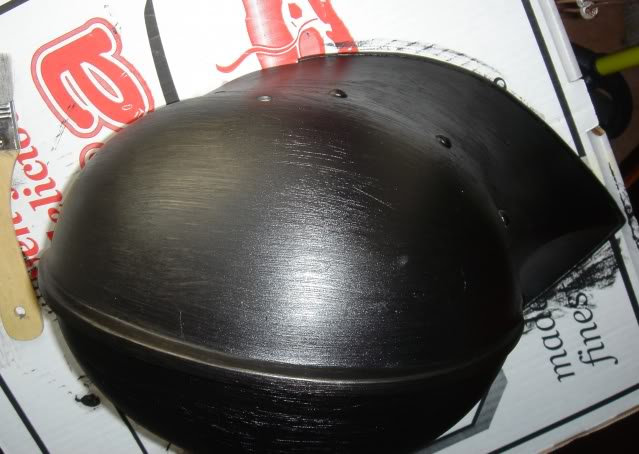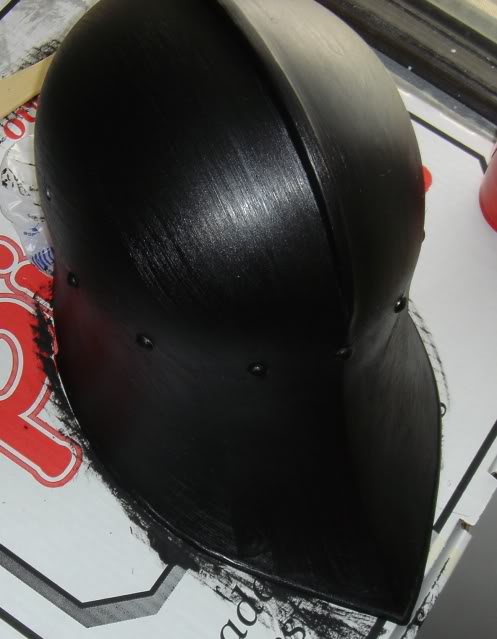| Author |
Message |
Nathan M Wuorio

|
 Posted: Thu 14 May, 2009 5:01 pm Post subject: Type of paint to use on armour? Posted: Thu 14 May, 2009 5:01 pm Post subject: Type of paint to use on armour? |
 |
|
I've seen people paint their armour, sometimes with a coat of arms or other image, and I was wondering what type of paint you would recommend to do this. I'm looking for something durable and inexpensive, hopefully with a wide range of colours. I have also seen historical examples of armour that seemed to be painted.
Nathan.
|
|
  |
 |
M. Eversberg II

|
 Posted: Thu 14 May, 2009 5:30 pm Post subject: Posted: Thu 14 May, 2009 5:30 pm Post subject: |
 |
|
Look into "milk paint".
M.
This space for rent or lease.
|
|
      |
 |
Justin B.

|
 Posted: Thu 14 May, 2009 7:46 pm Post subject: Posted: Thu 14 May, 2009 7:46 pm Post subject: |
 |
|
Based on my shield-painting experience... milk paint doesn't like to stick to metal very well at all. It'll probably require some kind of a base coat, which may or may not be available in a "period" formulation (if that's a concern for you).
Just as a heads-up =)
|
|
    |
 |
Chad Arnow
myArmoury Team


|
 Posted: Thu 14 May, 2009 8:02 pm Post subject: Posted: Thu 14 May, 2009 8:02 pm Post subject: |
 |
|
Weren't a number of shields and helm crests "primed" with gesso (some kind of plaster-like substance) before the paint was applied? That may be the key to getting the paint to stick.

ChadA
http://chadarnow.com/
|
|
    |
 |
Brian Hook

|
 Posted: Thu 14 May, 2009 8:49 pm Post subject: Posted: Thu 14 May, 2009 8:49 pm Post subject: |
 |
|
Nathan,
For my armour based painting projects, I use Linseed based oil paints. It is historically correct and it adds a nice authentic texture to the piece as well, it's also fairly inexpensive. The only problem with it is that oil paints are very slow drying so you will have to leave to the piece alone for a long time after you finish painting.
Depending on the type of oil paint you get and how thick of a coat you put on the piece it can take up to a few days to even a month or longer to dry. Another problem with it is can scratch off so prepare to touch it up now and again.
To prime the metal for painting I just take a 100 grit sanding sponge to it then paint and I haven't had any problems.
You can also use Galkyd slow drying medium on it the steel then after it dries apply the paint, but I haven't tried that.
Here's pictures of the Sallet I'm working on now after two coats of black oil paint. After this coat dries I'm going to do give it another black, then on to some yellow detailing.



Last edited by Brian Hook on Sat 16 May, 2009 2:36 pm; edited 2 times in total
|
|
  |
 |
Nathan M Wuorio

|
 Posted: Fri 15 May, 2009 7:48 pm Post subject: Posted: Fri 15 May, 2009 7:48 pm Post subject: |
 |
|
I have several pieces that I'm interested in painting, so I'll try a number of your solutions guys. I like the idea of the oil paint, and in your pictures the helmet looks really nice, is that an open faced sallet? I'm not planning on painting a large portion of my various armour pieces, just enough for a family coat of arms and such. Thanks for your suggestions!
Nathan.
|
|
  |
 |
Brian Hook

|
 Posted: Fri 15 May, 2009 8:15 pm Post subject: Posted: Fri 15 May, 2009 8:15 pm Post subject: |
 |
|
|
Yep it's an open faced sallet, wasn't originally but it's a loaner for my living history group to go with a lower class kit. That and the visor wasn't that great and kind of dangerous to boot. Good luck on your projects.
|
|
  |
 |
|
Jim Mearkle
|
 Posted: Sat 16 May, 2009 4:54 am Post subject: Posted: Sat 16 May, 2009 4:54 am Post subject: |
 |
|
To protect the inside of my gorget, I used gloss Rustoleum (rust-resistant paint). It's lasted at least 10 years now with only a few chips here and there. A matte finish might be better for the outer surface. I decided to just let mine patinate on the outside.
Jim
|
|
  |
 |
M. Eversberg II

|
 Posted: Sat 16 May, 2009 8:37 am Post subject: Posted: Sat 16 May, 2009 8:37 am Post subject: |
 |
|
| Chad Arnow wrote: | | Weren't a number of shields and helm crests "primed" with gesso (some kind of plaster-like substance) before the paint was applied? That may be the key to getting the paint to stick. |
Indeed; it smooths out the rough and irregular surface of the metal and prevents chemical reactions with it.
M.
This space for rent or lease.
|
|
      |
 |
Justin B.

|
 Posted: Sat 16 May, 2009 9:12 am Post subject: Posted: Sat 16 May, 2009 9:12 am Post subject: |
 |
|
| M. Eversberg II wrote: | | Chad Arnow wrote: | | Weren't a number of shields and helm crests "primed" with gesso (some kind of plaster-like substance) before the paint was applied? That may be the key to getting the paint to stick. |
Indeed; it smooths out the rough and irregular surface of the metal and prevents chemical reactions with it.
M. |
So gesso will adhere to bare (if, perhaps, sanded) metal? I've heard of it being used on linen before, but nothing else.
Any idea where one might find some of it? Regular ol' paint place?
|
|
    |
 |
Addison C. de Lisle

|
 Posted: Sat 16 May, 2009 10:13 am Post subject: Posted: Sat 16 May, 2009 10:13 am Post subject: |
 |
|
In one of my metals classes a girl applied gesso to sandblasted copper, so I'd imagine it would work for steel as well.
www.addisondelisle.com
|
|
   |
 |
|
Witek Chmielewski
|
 Posted: Sat 16 May, 2009 10:32 am Post subject: Posted: Sat 16 May, 2009 10:32 am Post subject: |
 |
|
| Justin B. wrote: | | M. Eversberg II wrote: | | Chad Arnow wrote: | | Weren't a number of shields and helm crests "primed" with gesso (some kind of plaster-like substance) before the paint was applied? That may be the key to getting the paint to stick. |
Indeed; it smooths out the rough and irregular surface of the metal and prevents chemical reactions with it.
M. |
So gesso will adhere to bare (if, perhaps, sanded) metal? I've heard of it being used on linen before, but nothing else.
Any idea where one might find some of it? Regular ol' paint place? |
Justin,
It does indeed adhere to bare metal, I know of a friend that uses it as primer to paint toy soldiers. You can get various kinds of coloured gesso as well if I'm not mistaken.
The gesso can be laid on relatively thick and gloopy but as it dries it will shrink to adhere to the surface.
Any good art supply shop, both brick and mortar and online, will usually carry at least the white gesso. Black gesso might save time if you're in a rush, as there won't be any white bits showing through if you miss a spot.
W.
|
|
  |
 |
Jared Smith

|
 Posted: Sat 16 May, 2009 1:04 pm Post subject: Posted: Sat 16 May, 2009 1:04 pm Post subject: |
 |
|
If it does not have to be historically correct (chemically), alkyd epoxy enamel based paints (rustoleum is an epoxy based example) are a general class of paints that adhere to clean or primed metal. You can get it in a variety of finish glosses and viscosity/ thickness applications. Non stainless structural steel and piping are generally painted with this type for indoor or outdoor purposes. I believe Wattyl makes and distributes it in non aerosol cans for hand brush application.
Absence of evidence is not necessarily evidence of absence!
|
|
  |
 |
M. Eversberg II

|
 Posted: Sat 16 May, 2009 1:44 pm Post subject: Posted: Sat 16 May, 2009 1:44 pm Post subject: |
 |
|
| Justin B. wrote: | | M. Eversberg II wrote: | | Chad Arnow wrote: | | Weren't a number of shields and helm crests "primed" with gesso (some kind of plaster-like substance) before the paint was applied? That may be the key to getting the paint to stick. |
Indeed; it smooths out the rough and irregular surface of the metal and prevents chemical reactions with it.
M. |
So gesso will adhere to bare (if, perhaps, sanded) metal? I've heard of it being used on linen before, but nothing else.
Any idea where one might find some of it? Regular ol' paint place? |
Yep, and yep. What you're after is the "shrinking" effect of gesso. It'll adhere to pretty much anything. At least, this is what I've been told by those artsy girls I dated years ago 
M.
This space for rent or lease.
|
|
      |
 |
|
Mark Shier
Industry Professional
|
 Posted: Sat 16 May, 2009 2:05 pm Post subject: painting metal Posted: Sat 16 May, 2009 2:05 pm Post subject: painting metal |
 |
|
I haven't seen any evidence for medieval milk paints in any of the surviving manuals, or in any conservation reports.
Medieval and modern oil paints often used linseed oil (extracted from flax). Linden oil would be from a lime tree (also known as basswood).
mark
Gaukler Medieval Wares
http://www.medievalwares.com
|
|
  |
 |
Brian Hook

|
 Posted: Sat 16 May, 2009 2:35 pm Post subject: Posted: Sat 16 May, 2009 2:35 pm Post subject: |
 |
|
|
Hey Mark I made a typo in my post above I meant to say I use linseed rather then linden seed. I don't even think they made an oil paint with linden seed as the drying medium.
|
|
  |
 |
Justin B.

|
 Posted: Sat 16 May, 2009 4:38 pm Post subject: Re: painting metal Posted: Sat 16 May, 2009 4:38 pm Post subject: Re: painting metal |
 |
|
Messrs Chmielewski and Eversberg: thanks for the info. Will file that away for possible use on some future project. And all apologies to the OP for the partial threadjack!
| Mark Shier wrote: | I haven't seen any evidence for medieval milk paints in any of the surviving manuals, or in any conservation reports.
Medieval and modern oil paints often used linseed oil (extracted from flax). Linden oil would be from a lime tree (also known as basswood).
mark |
With respect to milk paints, there extant examples of casein-based paints in use in ancient Egypt, at least one fragment of wood from Viking Age Scandinavia was determined to have (likely?) been painted with an egg-based paint. Not quite the same, I know, but reasonably close. The real advantage to milk paints, that I've found, anyway, is that they're bloody convenient.
Doubly useful if you have an irrational fear of linseed oil 
|
|
    |
 |
|
Mark Shier
Industry Professional
|
 Posted: Sat 16 May, 2009 7:57 pm Post subject: painting metal Posted: Sat 16 May, 2009 7:57 pm Post subject: painting metal |
 |
|
I'll rephrase that: I haven't seen any evidence for the use of milk paint between 1300 and 1500. The surviving painter's manuals describe egg tempered, size tempered and oil tempered paints. Analysis (mostly of paintings on walls, canvas, and wood supports) seems to agree with the manuals.
mark
Gaukler Medieval Wares
http://www.medievalwares.com
|
|
  |
 |
M. Eversberg II

|
 Posted: Sat 16 May, 2009 9:25 pm Post subject: Posted: Sat 16 May, 2009 9:25 pm Post subject: |
 |
|
That's true, Mark. I do know earlier sources do mention milk paint, however. I've not dabbled with the stuff myself.
What is "size" tempered, by the way? Not heard of it.
M.
This space for rent or lease.
|
|
      |
 |
Blaz Berlec

|
|
   |
 |
|
|

